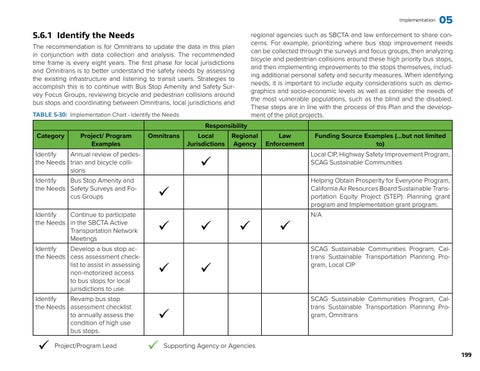Implementation
05
regional agencies such as SBCTA and law enforcement to share concerns. For example, prioritizing where bus stop improvement needs can be collected through the surveys and focus groups, then analyzing bicycle and pedestrian collisions around these high priority bus stops, and then implementing improvements to the stops themselves, including additional personal safety and security measures. When identifying needs, it is important to include equity considerations such as demographics and socio-economic levels as well as consider the needs of the most vulnerable populations, such as the blind and the disabled. These steps are in line with the process of this Plan and the development of the pilot projects.
5.6.1 Identify the Needs The recommendation is for Omnitrans to update the data in this plan in conjunction with data collection and analysis. The recommended time frame is every eight years. The first phase for local jurisdictions and Omnitrans is to better understand the safety needs by assessing the existing infrastructure and listening to transit users. Strategies to accomplish this is to continue with Bus Stop Amenity and Safety Survey Focus Groups, reviewing bicycle and pedestrian collisions around bus stops and coordinating between Omnitrans, local jurisdictions and Table 5-30: Implementation Chart - Identify the Needs
Responsibility Category
Project/ Program Examples
Omnitrans
Identify Annual review of pedesthe Needs trian and bicycle collisions Identify Bus Stop Amenity and the Needs Safety Surveys and Focus Groups Identify Continue to participate the Needs in the SBCTA Active Transportation Network Meetings Identify Develop a bus stop acthe Needs cess assessment checklist to assist in assessing non-motorized access to bus stops for local jurisdictions to use. Identify Revamp bus stop the Needs assessment checklist to annually assess the condition of high use bus stops.
Project/Program Lead
Local Jurisdictions
Regional Agency
Law Enforcement
Local CIP, Highway Safety Improvement Program, SCAG Sustainable Communities
Helping Obtain Prosperity for Everyone Program, California Air Resources Board Sustainable Transportation Equity Project (STEP): Planning grant program and Implementation grant program.
Funding Source Examples (...but not limited to)
N/A
SCAG Sustainable Communities Program, Caltrans Sustainable Transportation Planning Program, Local CIP
SCAG Sustainable Communities Program, Caltrans Sustainable Transportation Planning Program, Omnitrans
Supporting Agency or Agencies 199



















































